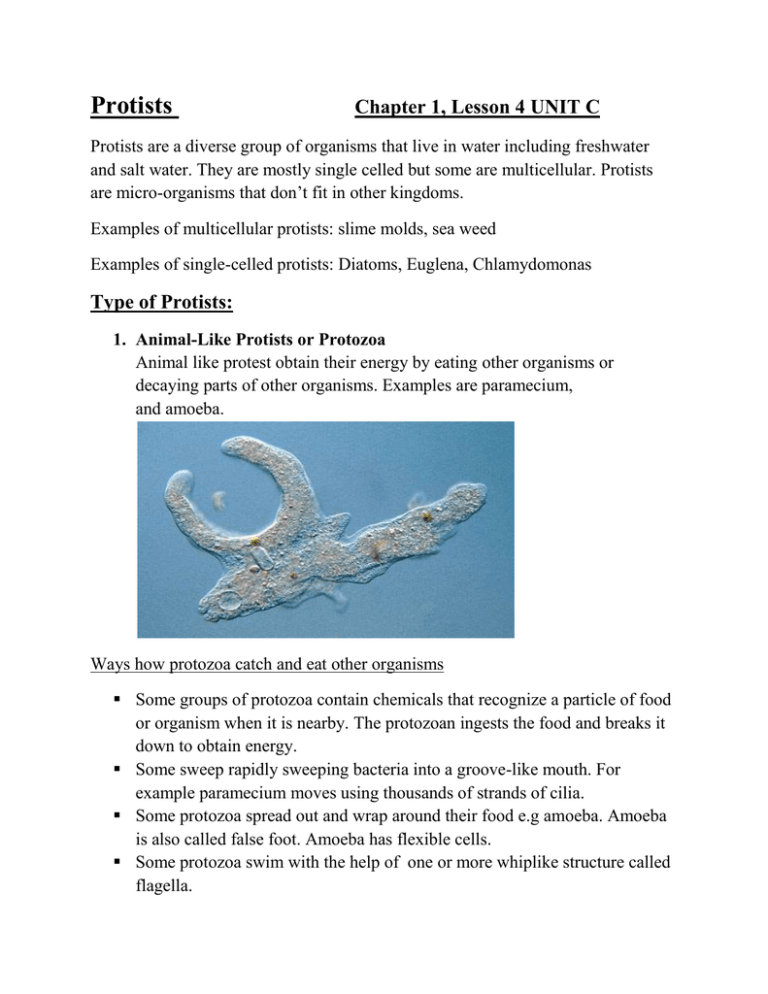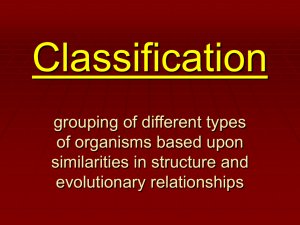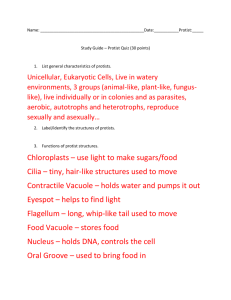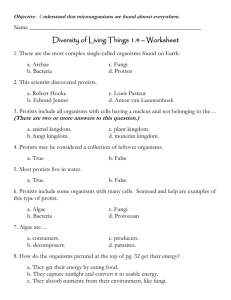Protists notes - WordPress.com
advertisement

Protists Chapter 1, Lesson 4 UNIT C Protists are a diverse group of organisms that live in water including freshwater and salt water. They are mostly single celled but some are multicellular. Protists are micro-organisms that don’t fit in other kingdoms. Examples of multicellular protists: slime molds, sea weed Examples of single-celled protists: Diatoms, Euglena, Chlamydomonas Type of Protists: 1. Animal-Like Protists or Protozoa Animal like protest obtain their energy by eating other organisms or decaying parts of other organisms. Examples are paramecium, and amoeba. Ways how protozoa catch and eat other organisms Some groups of protozoa contain chemicals that recognize a particle of food or organism when it is nearby. The protozoan ingests the food and breaks it down to obtain energy. Some sweep rapidly sweeping bacteria into a groove-like mouth. For example paramecium moves using thousands of strands of cilia. Some protozoa spread out and wrap around their food e.g amoeba. Amoeba is also called false foot. Amoeba has flexible cells. Some protozoa swim with the help of one or more whiplike structure called flagella. Some live as parasites e.g mosquito that carries parasite from human to human and cause malaria. 2. Fungus-Like Protists also called decomposers Fungus-like protist absorb food/materials from their environment, such as soil or other organisms. They break down dead organisms and other organic matter to get energy Examples are mold. What is mold? Mold refers to many organisms that produce a fuzzy-looking growth. Examples are water mold, which forms a fuzzy growth on food. Slime molds live on decaying plants on the forest floor. Plasmodial slime molds that looks like a fine net or lace, is one giant cell with many nuclei. 3. Plant-like Protist also called algae. A seaweed Algae get energy from sunlight. Algae contain chlorophyll, a green pigment that is necessary to capture the sun’s energy. Algae also use water and carbon dioxide from the air to and to transform energy and release oxygen in a process called photosynthesis. Examples of single celled algae are diatoms, chlamydomonas and volvox. What is plankton? All organisms that drift in water are called plankton. Plankton include the young of protest. What is phytoplankton? Plankton that perform photosynthesis are called phytoplankton (plantlike plankton). Give examples of phytoplankton. Algae and cyanobacteria that live in oceans and produce most of the oxygen animals need. What are three ways protist get their energy? There are three ways: a. Capture sunlight and convert it to usable energy (plant-like protist) b. Get energy from eating other organisms. c. Some absorb energy from their environment (funguslike protest) EUGLENA: Plant-like and animal-like Can do photosynthesis and consume food






